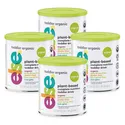How to Switch From Ready-Made to Powder Formula: A Smooth Transition
From ready-made to powdered: A smooth transition for your baby
Published August 29, 2024

The early months with a newborn are a whirlwind of excitement, but it can also be overwhelming for new parents. With so much information available, from books to blogs to well-meaning advice from friends and family, it can be hard to know what's best for your little one.
One common question concerns feeding. While breastfeeding is often recommended, formula is a healthy and convenient option. Many choose to start with ready-made, but powdered formula also has several advantages.
By understanding the benefits and following our expert tips, you can decide which option best suits your baby's needs. This will ensure your little one receives the essential nutrients they require for healthy growth and development.
» Nourish your little one without sacrificing your time. Try our nutritious powdered formula
Understanding the Difference
Knowing the key differences between ready-made and powdered formulas is essential for making an informed decision and preparing for a smooth transition.
Ready-Made Formula
- Easy to Use: Simply open, pour, and optionally heat.
- Convenient: No mixing required, saving valuable time.
- Consistent Nutrition: Premixed for accurate nutritional content.
- Ideal for On-the-Go: Perfect for travel or when you need a quick feed.
Powdered Formula
- Customizable: Can be mixed in different concentrations or with breast milk.
- Space-Efficient: Takes up less storage space in its powdered form.
- Cost-Effective: Generally more affordable than ready-made options.
- Variety: Often available in more types to meet specific dietary needs.
» Discover the key signs that formula isn't right for your baby
Why Make the Switch To Powdered Formula?
Parents choose to transition to powdered formula for several reasons:
- Cost Savings: As your baby grows and consumes more formula, the price difference between ready-made and powdered becomes more significant. Switching to powder can help manage the family budget.
- Specific Nutritional Needs: Some specialized formulas are only available in powder form, making the switch necessary if your baby requires a particular type of formula for nutritional deficiencies.
- Increased Flexibility: Powdered formula lets you prepare the exact amount you need, reducing waste. You can also adjust the concentration if recommended by your pediatrician.
- Storage Efficiency: The powdered form takes up less space, which is ideal for families with limited storage or those who like to keep a good supply on hand.
- Travel Convenience: While ready-made options are great for short trips, powdered formula is more practical for extended travel, as you can pack more meals in a compact space.
» Learn more about protein needs of infants and toddlers
Is Your Baby Ready for Powdered Formula?
While no specific developmental milestone indicates readiness for powdered formula, most babies can transition successfully at any age. But it's always best to consult with your pediatrician before significant changes to your kid's diet.
Some signs that your baby might be ready for the transition include:
- Consistent weight gain and growth
- Good overall health
- Established feeding routines
- Ability to digest their current formula well
» Understand how to promote healthy weight gain in toddlers
Strategies for a Smooth Transition
Transitioning to a new formula should be a gradual process. Here's a step-by-step approach to help make the switch as smooth as possible:
- Start Slow: Replace one bottle of ready-made formula with powdered formula daily. This helps you to gauge your baby's reaction to the new formula without overwhelming their system.
- Gradual Mixing: If your baby seems sensitive to the change, try mixing ready-made and powdered formulas in the same bottle. Start with a ratio of 3:1 (ready-made to powdered) and gradually increase the amount of powdered formula over a week or two.
- Maintain Consistency: Stick to your regular feeding schedule during the transition. Consistency in timing can help your baby adjust to the new formula more easily.
- Perfect Your Mixing Technique: Ensure the powder is well-dissolved to avoid a grainy texture. Follow the instructions on the package carefully, and consider using a formula pitcher for larger batches to ensure thorough mixing.
- Monitor Temperature: Some babies are sensitive to temperature changes. If you've been serving ready-made formula at room temperature, you might need to warm the powdered formula slightly to match what your baby is used to.
- Be Patient: Some babies adapt quickly, while others may take a few weeks to transition fully. Stay patient and positive throughout the process.
» Check out these tips for a gentle transition from breastfeeding
How to Switch to Powdered Formula
To make the transition as smooth as possible, consider these practical tips:
- Choose the Right Equipment: While most bottles work for both types, consider your baby's response. If your baby is struggling with the nipple or seems uncomfortable, you might need to experiment with different options.
- Prepare in Advance: Mix powdered formula just before feeding for the freshest taste. If you need to prepare in advance, store the pre-mixed formula in the refrigerator for up to 24 hours. Always follow safe handling and storage guidelines to prevent bacterial growth.
- Water Quality Matters: Use clean, safe water for mixing. If you're unsure about the quality of your tap water, consider using bottled water or boiling tap water and letting it cool before mixing.
- Measure Accurately: Use the scoop provided with your formula and follow the instructions precisely. Incorrect measurements can lead to over-concentration or dilution, potentially affecting your baby's nutrition and digestion.
- Rotate Stock: The powdered solution has a longer shelf life, but it's still essential to use before expiration. Implement a "first in, first out" system to ensure you always use the oldest product first.
- Travel Smart: Pre-measure powder into individual containers or bags for each feeding. This makes preparation quick and easy when you're on the go.
- Stay Informed: Follow the latest recommendations from pediatric health organizations regarding formula preparation and feeding. Guidelines can change, and staying informed ensures you always provide the best care for your baby.
» Support your child's healthy development through nutrition in their first 1000 days
Watch for Warning Signs
As you transition, be alert for signs that your baby isn't adapting well:
- Gastrointestinal distress (diarrhea, constipation, excessive gas)
- Unusual fussiness or irritability
- Changes in sleep patterns
- Refusal to feed or decreased appetite
- Skin rashes or other allergic reactions
- Changes in stool consistency or frequency
If you notice any of these signs, it's recommended to either slow down the transition or temporarily switch back to the previous formula.
» Discover the signs that indicate feeding issues in your baby
Addressing Common Concerns
The switch from ready-made to powdered formula is often a smooth experience. However, a few common worries may arise for parents during this transition. To help address these concerns, here are some useful tips:
- Taste Differences: Some kids may notice a difference in taste between ready-made and powdered formulas. If your baby seems resistant, try mixing the formulas as suggested earlier to help them adjust gradually.
- Clumping: If you're experiencing clumping issues, mix the powder with a small amount of warm (not hot) water first to create a smooth paste, then add the remaining fluid and shake well.
- Foam Formation: Powdered formula tends to foam more when shaken. Let the bottle sit for a few minutes to let the foam settle before feeding.
- Digestive Adjustments: Slight digestive changes are expected when switching formulas. These usually resolve within a few days to a week.
» Understand what causes picky eating and how to solve it
Personalized Feeding Made Easy
Switching from ready-made formula to powdered formula can be rewarding for many parents. It lets you become more actively involved in your baby's feeding routine, fostering a deeper connection and understanding of their needs.
While it may seem like an extra step, preparing powdered formula doesn't have to be time-consuming or stressful. With a little practice, it will become an easy part of your daily routine. By taking a more hands-on approach, you'll gain a sense of satisfaction knowing you're providing your baby with the best possible nutrition.
» Discover the versatility of powdered formula for a convenient and healthy feeding experience
The content and advice provided in this article are for informational purposes only and are not a substitute for medical diagnosis, treatment, or advice for specific medical conditions. Always consult a pediatrician to understand the individual needs of your child.










